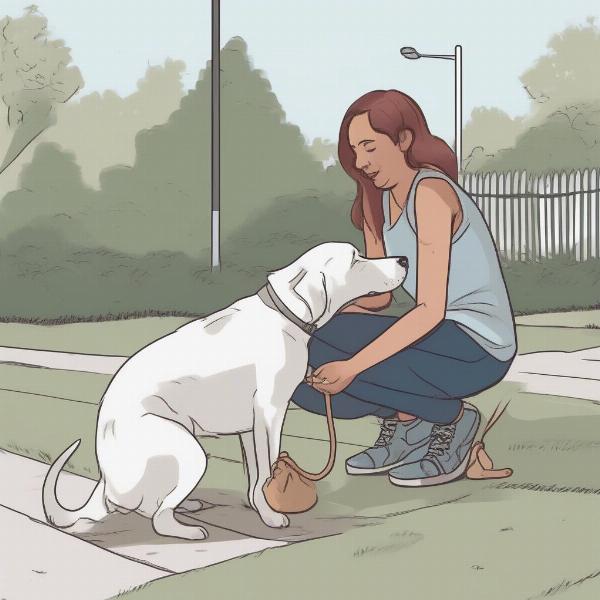A nervous dog on a lead can be a stressful experience for both the dog and the owner. This nervousness can manifest in many ways, from pulling and lunging to freezing and refusing to move. Understanding the root cause of this anxiety is crucial to addressing it effectively. Whether your dog is new to lead walking or has developed a fear later in life, this article will provide practical advice and techniques to help you build confidence and create positive lead-walking experiences for both of you.
Many factors contribute to a dog’s anxiety while on a lead. It could stem from a lack of early socialization, past negative experiences, or simply an overwhelming environment. Certain breeds are also more predisposed to anxiety than others. Identifying the specific triggers for your dog’s nervousness is the first step towards creating a positive lead-walking experience. This article will explore common causes of lead anxiety, training techniques, and tools to help your dog overcome their fear and enjoy walks with you.
Identifying the Causes of Lead Nervousness
Before tackling the issue, it’s important to pinpoint the underlying reasons behind your dog’s nervousness. Is it fear of other dogs, loud noises, or unfamiliar surroundings? Observing your dog’s behavior and reactions will provide valuable clues.
- Lack of Socialization: Puppies not exposed to a variety of sights, sounds, and experiences during their critical socialization period may develop anxieties later in life. This can manifest as nervousness on a lead when confronted with unfamiliar environments.
- Past Trauma: A negative experience, such as being attacked by another dog while on a lead, can create a lasting fear associated with lead walking.
- General Anxiety: Some dogs are simply more prone to anxiety, and this can be amplified when restrained by a lead.
Training Techniques for a Nervous Dog on a Lead
Patience and positive reinforcement are key when working with a nervous dog. Avoid punishment, as this will only exacerbate the anxiety. Instead, focus on building positive associations with the lead and walking.
- Desensitization: Gradually introduce your dog to the lead and walking in a controlled environment, starting with short sessions in a quiet, familiar area. Reward calm behavior with treats and praise.
- Counter-Conditioning: Pair the lead with something positive, such as a favorite toy or treat. This helps to change the dog’s emotional response to the lead from fear to anticipation.
- Positive Reinforcement: Reward your dog for any positive behavior while on a lead, such as walking calmly beside you or making eye contact.
 A dog owner giving a treat to their dog while on a lead, practicing positive reinforcement.
A dog owner giving a treat to their dog while on a lead, practicing positive reinforcement.
Choosing the Right Lead for a Nervous Dog
The type of lead you use can also influence your dog’s comfort level. leads for nervous dogs are designed to provide more control and security, reducing the dog’s anxiety.
- Harness: A harness distributes pressure more evenly across the dog’s body, preventing choking and reducing pulling. puppy harnesses for small dogs are particularly useful for smaller breeds.
- Double-Ended Lead: This allows for greater control, especially in busy environments, while still giving the dog some freedom.
- Nervous Dog Lead: A specialized nervous dog lead or a nervous dog lead sleeve can provide additional comfort and security.
Calming Aids for Nervous Dogs
In some cases, calming aids can be helpful in conjunction with training. calming herbs for dogs can offer a natural way to reduce anxiety.
“For dogs with severe anxiety, combining behavioral modification techniques with calming aids can be incredibly effective,” says Dr. Emily Carter, a certified veterinary behaviorist.
Conclusion
Helping a nervous dog overcome their lead anxiety requires patience, understanding, and consistent training. By identifying the root causes, employing positive reinforcement techniques, and utilizing the right tools, you can transform walks from a stressful experience into an enjoyable activity for both you and your furry friend. Remember to celebrate even the smallest successes, and with time and dedication, you’ll build a strong bond of trust and create a positive, confident walker.
FAQ
- Why is my dog suddenly nervous on the lead? Sudden changes in behavior can be due to various factors, including a traumatic experience, illness, or changes in the environment.
- What type of lead is best for a nervous dog? Harnesses or double-ended leads are generally recommended for nervous dogs.
- Can I use calming aids for my nervous dog? Consult with your veterinarian before using any calming aids.
- How long does it take to train a nervous dog on a lead? The timeframe varies depending on the individual dog and the severity of their anxiety.
- Should I punish my dog for pulling on the lead? Never punish a nervous dog, as this will only worsen their anxiety.
- What are some signs of a nervous dog on a lead? Signs include pulling, lunging, freezing, panting, whining, and tucked tail.
- How can I socialize my dog to reduce lead anxiety? Gradual exposure to different environments, sights, sounds, and people can help desensitize a nervous dog.
ILM Dog is a leading international website dedicated to providing expert advice and resources on all aspects of dog care and wellbeing. From breed selection and health to training and nutrition, we offer a wealth of information to help dog owners provide the best possible care for their furry companions. Our team of experienced writers and dog experts are passionate about sharing their knowledge and helping you build a strong, loving bond with your dog. For more expert advice and tailored guidance, contact us at [email protected] or call us at +44 20-3965-8624. ILM Dog is your trusted source for all things dog-related.